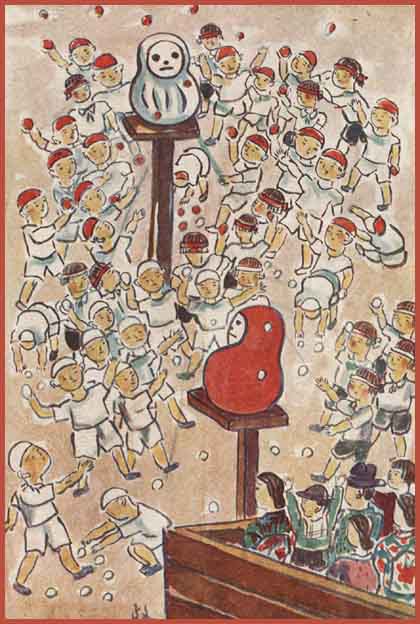[ . BACK to DARUMA MUSEUM TOP . ]
:::::::::::::::::::::::::::::::::::::::::::::::::::::::::::::::::::::::::::::::::::::::::::::::::::::
Suiseki stones ... 水石
Stones for Appreciation


The Japanese name is derived from SANSUI, landscape painting with mountains and water ...
山水石 。。。 水石
JAPANESE : NHK, Bi no Tsubo, File 97
:::::::::::::::::::::::::::::::::::::::::::::::::::::::::::::::::::::::::::::::::::::::::::::::::::::
quote by Michael:
For centuries, hauntingly beautiful stones have captivated the imagination of collectors with their power to suggest a scene or object. The suggestive possibilities of suiseki are almost limitless, very much like looking at a cloud and seeing running stallions or angels, images unlimited by imagination. In the suiseki world, often heard is the term "wabi-sabi," referring to the deep spiritual understanding of /connection with a suiseki stone.
Prized suiseki are not replicas of natural objects they represent -- instead, they merely suggest the object and capture the object's essence with simple gestures; they awaken the imagination, inviting the viewer to complete the picture. They are simplicity, in accordance with Zen teachings. They are "less is more" captured in stone.
Aesthetic Qualities
Suggestiveness
Subdued Color
Balance
Wabi (inward, spiritual)
Sabi (aesthetics, art)
Shibui (restrained elegance)
Yugen (sudden perception of the elusive)
 Learn more HERE:
source : Suiseki.com ~ The Art of Stone Appreciation
More English Reference !
Learn more HERE:
source : Suiseki.com ~ The Art of Stone Appreciation
More English Reference !
:::::::::::::::::::::::::::::::::::::::::::::::::::::::::::::::::::::::::::::::::::::::::::::::::::
Basic Information about Suiseki
by Martin Pauli
Sansui ishi (landscape stone)
In Europe a typical mountain is such one like Matterhorn of sharp edged, vertically oriented shape. The ideal mountain in Japan is Mt. Fuji. A horizontally oriented, well balanced mountain with slopes descending softly to the ground, its peak surrounded by clouds.
Sugata-ishi (human shape stone)
If a person in the West will be approached by a stone representing a human shaped it would rather by a stone looking like a famous actor or a garden dwarf. A personage in the eyes of a Japanese person would rather be one of the 33 appearances of Bodhisattva Kannon or an appearance of Daruma, maybe a dancer from the Nara period.
Keisho ishi (object shape stone)
If a stone suggest us a boat, we see a steamboat or a sailboat, the Japanese see a vague suggestion of the treasure boat (takarabune), which plays an important role in Japanese history.
Dokutsu-ishi (animal shape stone)
Westerner sees a dog, a wolf, a dinosaur a cat just because of, it reminds us to it. Japanese do not have the same relation to dinosaurs or wolfs, they appreciate a vague suggestions of animals, which play a specific role in their culture and life. The fox (Inari) for example is one of the many commonly known ghosts (kami), if something goes wrong it must have been the fox.
First element: Shape (katachi)
This is the most important element in judging the relative qualities of a suiseki. The most common method of appreciation is to sit at some distance from the front of the stone and gaze at it. Any stone that has an unnatural feeling at the first glimpse is considered unsuitable. We can also mention the following about the ideal method of viewing a stone.
Three Surface Method (sanmen no ho)
This is considered to be the most basic approach to appreciating suiseki. Three surfaces (sanmen) refer to the front & back, the left & right, and top & bottom of the stone. A balance among these different surfaces is considered to be basic when viewing and judging a stone.
When viewing a stone from the vantage point of these three surfaces, there should be a balance in terms of mass and shape. An outstanding stone is also one in which there is a harmony regarding the size, thickness and shape of the three surfaces.
For an example, if there is a mountain foot on the front of a distant mountain stone (toyama ishi), there ideally should be a foot section on the back as well.
If the right side of the mountain protrudes out, there must also be an extension of some degree on the left side as well. The bottom of the stone is good when the stone „sits“ well in the center in relation to the whole. However, these are all ideals. In actual practice, the three surfaces should basically display a representative form and a certain degree of unity.
Left & right: Same like front and back, the mountains shall look harmonious and natural. The mountain food shall run out on the left side and on the right side. The peek of a mountain shall ideally stand one third from the left or right side, following the principle of the golden section
Top & bottom: Seeing from top, the stone should bend a little toward the viewer, as bonsai should. The stones middle section shall be deeper than its ends. The stones bottom should be - more or less - flat, natural, not cut (It’s allowed to remove a small protrusion if it makes it difficult to place it in the tray (suiban) or carved wooden stand (daiza).
 Read more here:
source : suiseki-beautifulstones.
Read more here:
source : suiseki-beautifulstones.
:::::::::::::::::::::::::::::::::::::::::::::::::::::::::::::::::::::::::::::::::::::::::::::::::::::
Daruma Suiseki だるま水石、水石だるま
無題だが丸みがあってダルマのようにも見える。
 © PHOTO : kansyou-art.jugem.jp
© PHOTO : kansyou-art.jugem.jp
:::::::::::::::::::::::::::::::::::::::::::::::::::::::::::::::::::::::::::::::::::::::::::::::::::
Daruma Stone from River Abekawa, Shizuoka
安倍川鉄丸石 .. ダルマ石



PHOTOS : 猿投庵
. Abekawa, Abe-Kawa 安倍川 / 阿部川 - place names .
:::::::::::::::::::::::::::::::::::::::::::::::::::::::::::::::::::::::::::::::::::::::::::::::::::
These ones looks like a Daruma to me !
 © PHOTO : José Manuel Blázquez. Wikimedia
© PHOTO : José Manuel Blázquez. Wikimedia
 © PHOTO : www.bonsaiinformation.com/
© PHOTO : www.bonsaiinformation.com/
:::::::::::::::::::::::::::::::::::::::::::::::::::::::::::::::::::::::::::::::::::::::::::::::::::::
The appreciation of stone art began in China over 1000 years ago.
From there, it gradually found its way to Korea, Japan and other parts of the world. Nowadays, suiseki, like bonsai, has become an international phenomenon. Many suiseki clubs, often associated with bonsai enthusiasts and bonsai clubs, have sprung up around the world.
Suiseki was first known to have been introduced to Japan during the reign of Empress Regent Suiko around 600 A.D. as a gift from the Chinese imperial court. The Chinese stones, now known to the West as
scholar's rocks, were of abstract shapes with bizarre and strange looking but awe inspiring. These stones were fantastically and beautifully shaped often in vertical positions, twisted forms with dramatic overhangs, large and small perforations with projecting terraces and deep crevices with sometimes heavily eroded surfaces.
The appreciation of Chinese stones became popular in Japan, but over the years as the time passed, Japanese connoisseurs of stone slowly moved away from the Chinese styles. Japanese adapted their own aesthetic values as more subtle and horizontal in shapes and depicting the forms of landscape such as of mountains, hills or plateau, or objects such as human, animals or plants. Thus the classification of suiseki was developed.
Suiseki can be classified by shape, surface patterns, place of origin or colors. Suiseki in many aspects is representations of mini-universes surrounding us resembling landscape, objects or others. A stone is just a stone until it has been found and perceived with artistic inspiration. The beauty of the stone can be a matter of a personal taste or can be subject to the rules of the classification such as in suiseki.
Look at more here:
source : www.luckywonders.com
 More about Scholar's Rocks
More about Scholar's Rocks
.................................................................................

Elegant Stone Artifacts, The Best Collection of Dianbai Golden Wax Stone.
Yangchun Malachite.
Zhonggo juhuashi. Chinese Chrysanthemum Stones.
Complete Collection and Appreciation of Chinese Fantastic Stones.
Introductory Level Encyclopedia of Stone Collection.
Fine Elements and Cream Developed Over Time.
An Assemblage of High Quality Lingbi Stones in Baocheng Museum in China.
Lingbi of China.
Wax Stones of Southern China (Lingnan Cerostone of China).
China Chaohou Wax Stone Collection.
Malachite in China.
Chinese Stone Appreciation Masters.
books available on Chinese stone appreciation
source : www.vsana.org
 Kernels of Energy, Bones of Earth :
Kernels of Energy, Bones of Earth :
The Rock in Chinese Art
Hay, John

Worlds within worlds
Robert D. Mowry
:::::::::::::::::::::::::::::::::::::::::::::::::::::::::::::::::::::::::::::::::::::::::::::::::::::
spring melancholy -
the scholar's rock
on my desk
The desk as the symbol of the life of a recluse or Daoist saint.
:::::::::::::::::::::::::::::::::::::::::::::::::::::::::::::::::::::::::::::::::::::::::::::::::::::
Exhibition of Stone Art 水石展 だるま

 Daruma stones
Daruma stones
In Suruga、Shizuoka town 駿河、静岡市
August 2008
:::::::::::::::::::::::::::::::::::::::::::::::::::::::::::::::::::::::::::::::::::::::::::::::::::::
quote
Timeless Fascination:
Scholar’s Rocks at the Musée Guimet
This spring, the Musée Guimet will present the exhibition ‘The Roads of Art in China and Scholar’s Rocks’ (28 March-26 June, 2012).
First used in the Han dynasty (206 BCE-220 CE) to mimic the mountain islands of the immortals in imperial gardens, then set in illustrious elite gardens that imitated the entire universe, rocks weathered by nature into unusual forms were first collected for the studio in the Song dynasty (960-1279). ‘Scholar’s rocks’, as they came to be known, exerted a peculiar fascination as ‘living’ witnesses of the innumerable transformations of the primordial energy, qi, through the ages.
source : www.orientations.com

Rochers de lettrés, itinéraires de l'art en Chine
Au total, une centaine d’objets seront exposés, car outre les pierres seront présentés d’autres objets, ceux qui accompagnent depuis toujours les activités des lettrés, peintres et calligraphes de par leur formation, bien sûr, mais aussi et surtout du fait de leur sensibilité personnelle : pots à pinceaux, pierres à encre, pose-pinceaux etc.
Les pierres qui portent en elles les forces telluriques de l’univers, ont reçu des noms poétiques comme « racines de nuages » ou encore, « os de la terre » On dit aussi qu’elles étaient des pans de la voûte céleste tombés sur notre sol.
source : www.guimet.fr
:::::::::::::::::::::::::::::::::::::::::::::::::::::::::::::::::::::::::::::::::::::::::::::::::::
Daruma stones ...
this view of coolness
in my garden
Stones and Daruma 石、岩とだるま だるまいし、達磨石、石達磨
Daruma Museum
:::::::::::::::::::::::::::::::::::::::::::::::::::::::::::::::::::::::::::::::::::::::::::::::::::::



























































